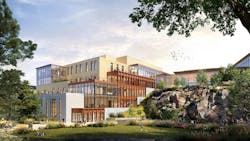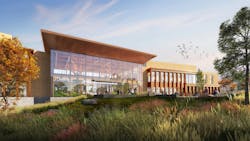HGA unveils plans to transform an abandoned rock quarry into a new research and innovation campus
By Novid Parsi, Contributing Editor
In the coastal town of Manchester-by-the-Sea, Mass., an abandoned rock quarry will be transformed into a new research and innovation campus designed by HGA. The campus will reuse and upcycle the granite left onsite.
The project for Cell Signaling Technology (CST), a life sciences technology company, will turn an environmentally depleted site into a net-zero laboratory campus, with building electrification and onsite renewables. The building’s heating, cooling, and hot water will be sourced from geothermal energy. The sustainable campus will target LEED, LEED Zero Carbon, and WELL certifications.
“This is an architect’s dream—to marry our design thinking and holistic approach with CST’s project aspirations while transforming an abandoned quarry into a new campus for life sciences research,” Samir Srouji, principal with HGA, said in a statement.
To support everyday life and employee wellbeing, the design includes a Quarry Garden and Upper Quad designed by landscape architects Studio 2112. These outdoor spaces will connect to a network of trails around the site. A primary circulation route will direct activity from the cloistered Upper Quad, the heart of the campus, to the Quarry Garden, located at the cliff’s base.
The project prioritizes low embodied carbon and healthier materials. Proposed materials include a natural granite base with brick cladding, curtain wall technology with vacuum-insulated glazing, and mass timber structure for the multipurpose lobby pavilion. To foster a thriving natural ecosystem, the project includes native plantings, resilient stormwater management, and a woodland environment.
Sightlines will extend throughout the building, providing natural light and an unobstructed view of the surrounding landscape and the scientists at work. In the flexible open lab environment, robust mechanical, electrical, and plumbing systems will enable the facility to adapt to new technology and instruments in the future.
On the Building Team:
Owner: Cell Signaling Technology
Design architect and architect of record: HGA
MEP and structural engineer: BR+A
General contractor: Columbia


